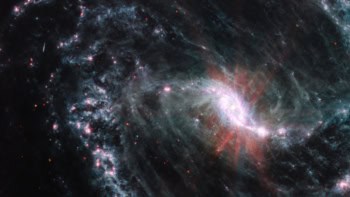
A massive and exotic type of neutron star could be formed by the merger of two neutron stars and avoid becoming a black hole – at least temporarily. That is the conclusion of Arthur Suvorov at Manly Astrophysics in Australia and Kostas Glampedakis at Germany’s University of Tübingen who have calculated that magnetically supramassive neutron stars could stave off gravitational collapse, despite lying above the theoretical mass limit for black hole formation.
In 2017 the LIGO–Virgo collaboration detected the first gravitational waves emanating from two neutron stars as they spiralled into each other, and eventually merged. This event provided important opportunities for astronomers to study the aftermath of the merger using a range of different telescopes, but key questions remain about the object that was created.
Neutron stars are expected to have masses that are at least 1.1 times the mass of the Sun, so when two neutron stars merge, they can create an object with a mass that is greater than the Tolman–Oppenheimer–Volkoff limit. Above this limit, which is believed to be 2–3 solar masses, a neutron star created in a merger is expected to collapse immediately to a black hole.
Magnetic effect
The Tolman–Oppenheimer–Volkoff limit applies to non-rotating neutron stars, and astrophysicists believe that more massive neutron stars can avoid collapse temporarily if they are spinning. In this latest theoretical analysis, Suvorov and Glampedakis have shown that a neutron star above the Tolman–Oppenheimer–Volkoff limit could also avoid collapse if it was created with a magnetic field some 1017 times stronger than that of the Sun.
The duo reckon that these “magnetically supramassive” neutron stars could then stave off collapse for roughly 1–10 years as the strength of the magnetic field wanes. The exact timescale depends on the star’s core temperature, internal field strength, birth mass, and the relation between its mass and density.

Gravitational waves reveal radii of colliding neutron stars
Suvorov and Glampedakis believe that the formation of a magnetically supramassive neutron star would be accompanied by short gamma-ray bursts, followed by an intense but short-lived X-ray afterglow. On its collapse to a black hole, the resulting magnetic shocks would accelerate surrounding electrons to relativistic speeds, producing a flash of fast radio bursts.
If their calculations are correct, the duo believes that these characteristic signals could be observed by existing telescopes. If so, they could be picked up in tandem with future observations of gravitational waves emanating from merging neutron stars. They say that such multimessenger observations would provide a “smoking gun” signature, offering concrete evidence that this exotic variety of neutron star can exist.
The research is described in Physical Review D.



